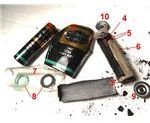A Sulphur Cycle
In the cycle shown below there are three separate chemical reactions represented:
The element sulphur is found in volcanic areas. It forms yellow deposits around the crater of a volcano.
In the cycle shown below there are three separate chemical reactions represented:
-
Reaction 1 :
Sulphur powder is heated strongly with iron filings
in a test tube. After a while the contents of the tube will glow and
iron II sulphide is formed.
-
Reaction 2 : Once the iron II sulphide has cooled down dilute hydrochloric acid is added to it.
This is done in a fume cupboard since one of the
products, hydrogen sulphide gas, has a pungent odour similar to bad
eggs. The hydrogen sulphide gas is collected in a gas jar.
- Reaction 3: Oxygen gas is mixed with the hydrogen sulphide gas. A lighted match will ignite these two gases. The products of this reaction are water and powdered sulphur.
 |






















